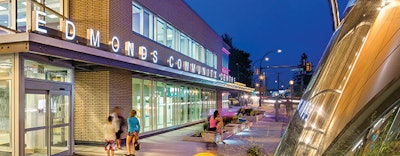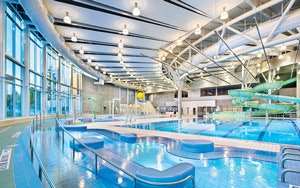
New public recreation facilities all share similar starting points. The municipality has determined either that it has greater needs than it currently has space, or that its current offerings have left certain neighborhoods or user groups underserved. Recreation officials believe they have a good handle on exactly what is needed and where, but because of the agency's charge to serve the public and the need to get community members behind the project, they decide to bring the community at large into the conversation about what the priorities should be.
This is sure to set off an immediate scramble among various potential stakeholders to lobby for their particular group or favored activity. But one very basic question, telegraphed by one subtle matter of word choice, will determine who from the community gets a seat at the table. Are you building Anytown Recreation Center, Anytown Wellness Center, or Anytown Community Center — or some combination thereof? The difference may seem purely semantic, but it will alter the planning and eventual design of a facility.
 Click to enlarge
Click to enlarge
BUILDINGS WITH A PURPOSE
Do you know the difference between the three types of centers mentioned? Is it even important in an era in which all three are likely to share the primary components of gymnasium, fitness center and pool? Doesn't the fact that any of the three could be home to a climbing wall render the distinction meaningless?
Not at all. If the name is an accurate representation of a building's primary purpose, the choice will come with a lot of implications for building owners as well as for architects. Let's break it down:
• Recreation Center. A recreation center is a place for leisure activities; in Canada, we have Leisure Centers (or rather, Centres) "where people go to keep fit or relax," notes a Wikipedia entry. That same entry goes on to say "Many of its functions may overlap with that of a community centre," which shows you how difficult it is to distinguish between these buildings.
The planning of a recreation center will bring the general public into discussions of potential building components — a "sports and recreation center" will go even further toward bringing sport clubs, swim clubs and secondary schools to the table — and the eventual building plan will highlight its active components, including some meant for competition (a track, a pool) as well as recreation.
• Wellness Center. First there were "fitness" centers, which were obviously intended for people interested in physical fitness. At a certain point, however, the concept of wellness overtook the simpler concept of fitness, offering something more holistic — akin to the YMCA's longtime focus on "body, mind and spirit."
 THE NAME GAME A building’s name should be an accurate representation of its primary functions.
THE NAME GAME A building’s name should be an accurate representation of its primary functions.
Accordingly, your announcement of a planned wellness center (or fitness and wellness center, or recreation and wellness center) will send a charge through people interested in yoga and other group exercise programs, and tend to bring these components to the foreground as the first plans are drawn. Components such as spas (massage rooms, meditation rooms) and general health-related spaces where residents can learn more about good nutrition and other health issues may be added, as well.
• Community Center. This is a building that first and foremost brings people together. The user groups won't be defined by the activities they pursue — swimmers, yoga enthusiasts, basketball teams — but rather by their age, gender or (subtly) socio-economic status. Children, seniors, teens or at-risk youths, mother-baby groups and others will look to the planned community center as a place to hold afterschool programs, lock-ins, study sessions and social events, even as the building's program looks very much like that of a recreation center.
A common admonishment to planners of any new sports or recreation-oriented center is that they shouldn't try to be everything to everybody. Of the three types listed here, the community center comes closest to attempting this. Think of it this way: The health club industry notes that just 15 percent of the U.S. and Canadian population holds a fitness center membership, and data compiled by the National Federation of State High School Associations shows that 55 percent of U.S. high school students participate in school sports programs. A community center theoretically serves 100 percent of the people in the surrounding community, just by targeting residents rather than focusing on exercise enthusiasts or sports participants.
 COMMUNAL USE As opposed to facilities that stress activities, such as fitness or recreation, community centers tend to be organized around the needs of its demographic groups.
COMMUNAL USE As opposed to facilities that stress activities, such as fitness or recreation, community centers tend to be organized around the needs of its demographic groups.
COMMUNITY PLANNING
The differences in design between each type of facility are subtle, but they're there. As an example, the recently completed Edmonds Community Centre in Burnaby, B.C., replaces a much smaller facility on the same site that had a single gymnasium, one large multipurpose room and a small youth room. The new facility has two full-size gymnasiums, a natatorium (comprising a 25-meter pool and a 15-meter warm-water leisure pool), a fitness center, an active studio (for yoga, fitness and dance), six multipurpose rooms, a seniors lounge, a youth lounge and a preschool/playcare center that features an indoor playground.
Buildings that give primacy to activities tend to shunt spaces for different age groups to the margins. In the case of Edmonds, this is reversed, as space adjacencies make clear. The seniors lounge is located just to the left of the front entry, with the idea being that older visitors have a shorter walk to their dedicated space and can see the bus stop so they can avoid a long wait outdoors for the next bus. The youth center, on the other hand, is farthest away from the front entry, with direct access to the gymnasium and (through a secondary means of egress) the outdoor fields to the rear of the facility. The separate entrance was also important for its symbolism: Teens would prefer that their space is theirs alone (whereas seniors prefer to mix with younger people). Child spaces are located just to the right of the entry for easy drop-off, and the indoor playground is fronted by a sitting area for parents who opt not to work out, or for seniors and other visitors who enjoy watching the children play.
 Click to enlarge
Click to enlarge
Also given a high profile is a community kitchen, which was included next to the seniors lounge after one mother spoke of its benefits during the public consultation and design process. The mother, a Congolese immigrant, said that a kitchen could give her and other immigrants a place to meet — in essence, "even if we don't speak the same language, we all know what to do with a tomato."
Recreational facilities of all types serve communities that have distinct populations and interests, which is why there is no template for facility design. But something as simple and nonspecific as the facility type (and name) will begin to shape the municipality's narrative about the way it intends to meet the needs of its residents — and such a narrative can't help but alter not only the way architects approach the project, but how would-be users assess its end purpose.
Mark Hentze ([email protected]) is a partner with CEI Architecture in Vancouver, B.C.




































